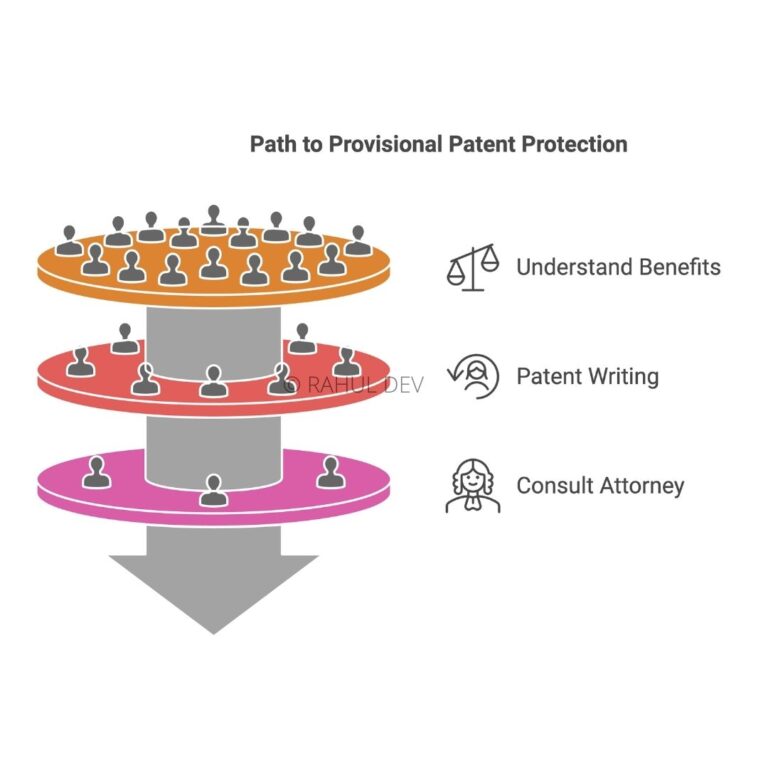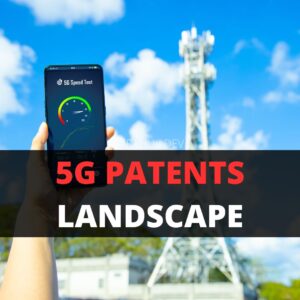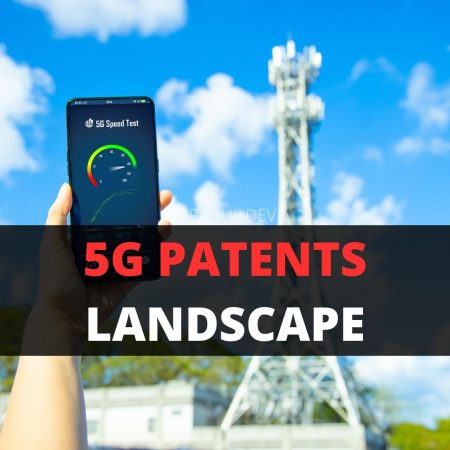5G Patents Landscape
Explore the Growth of 5G Technology Innovations

Understand Practical Aspects
Understand the role of 5G in Advertising

Explore the Growth of 5G Technology Innovations

Understand the role of 5G in Advertising

Protect your innovations across multiple countries and create strong patent portfolio to boost business valuation
Local and global brand protection through international trademark registrations
Extensive research and business writing for technical whitepapers and B2B content products
The 5G patent landscape is undergoing rapid evolution as 2025 approaches, with prominent contributions from several Fortune 500 companies. This dynamic environment necessitates examining recent developments and authoritative sources to uncover niche insights, address frequently searched questions, and outline best practices for navigating this complex domain. Huawei Technologies Co. Ltd. continues to dominate the 5G Standard Essential Patents (SEPs) landscape. According to a 2022 report by Clarivate, Huawei boasts the largest number of SEPs, with a patent family count of 6,566 and the fastest growth rate among competitors. Similarly, Samsung Electronics Co., Ltd. has made noteworthy contributions, ranking first in 5G SEP shares as reported in 2021 by IPlytics. Ericsson has also played a critical role, with approximately 50,000 contributions to 3GPP standards spanning 2G through 5G, underscoring its influence on industry benchmarks.
The importance of SEPs in implementing 5G technology cannot be overstated. These mobile technology patents ensure interoperability by allowing companies to license critical technologies essential for compliance with 5G standards. Huawei’s leadership, followed closely by Samsung and Ericsson, highlights the strategic significance of patent ownership in defining global technology leadership. This distribution of patents not only influences economic and technological advancements but also shapes national competitiveness and security.
The patent quality and essentiality remain critical considerations in this domain. As Ericsson emphasizes, relying solely on the number of declared patents can be misleading; instead, companies should focus on genuinely essential patents supported by rigorous patent claim charts. Furthermore, fostering innovation through cross-licensing agreements offers significant benefits. For instance, Nokia and Samsung’s 2023 multi-year cross-license patent agreement exemplifies collaborative strategies that mitigate litigation risks while enabling shared technological progress.
The 5G patent landscape is also shaped by geopolitical factors. U.S. sanctions on Chinese tech firms, including Huawei, have intensified the need for companies to navigate international trade policies and regulatory challenges. Despite such hurdles, Huawei has leveraged substantial state support to strengthen its global position while reducing reliance on American suppliers. Finally, the landscape’s dynamism is reflected in initiatives such as Apple’s plan to develop proprietary cellular modem chips by 2025, aiming to reduce dependence on Qualcomm. As China is projected to lead 5G adoption globally with 416 million connections by 2025, stakeholders must strategically navigate the complexities of this evolving field to maintain competitive advantage and drive technological innovation.
This article covers following topics:
Role of 5G Technology in 5G Patents Landscape
AR Technology and 5G Patents Landscape
Growth of AR and VR in Marketing in 5G Patents Landscape
Role of VR Technology in 5G Patents Landscape
Hyper-Targeted Advertising and 5G Patents Landscape
IoT in Advertising and 5G Patents Landscape
5G Technology Applications and 5G Innovation
5G Regulatory Landscape and Future Development


The adoption of 5G technology is revolutionizing the 2025 advertising landscape, enabling innovative applications of AR and VR. A key takeaway from the provided analysis is that 5G facilitates immersive, real-time customer engagement through hyper-targeted and interactive experiences, leading to measurable business growth. For instance, Times Square’s interactive 5G-powered billboards in 2024 showcased the transformative potential of dynamic ads by boosting engagement rates by 35%.
With over 20 years of expertise spanning intellectual property law, technology innovation, and business strategy, I have analyzed multiple tech projects and guided enterprises leveraging 5G to protect their 5G innovations through creation of strong patent portfolios. One practical application observed while reviewing the 5G patents landscape is the seamless integration of AR in retail advertising. The IKEA app mentioned demonstrates how AR-driven customer experiences translate into increased sales, which are projected to reach $24.2 billion by 2033 (LinkedIn report, 2023). Supporting data from Deloitte Insights further indicates that 90% of marketing professionals anticipate significant industry disruption due to 5G within the next decade. Furthermore, AR’s capacity to personalize and localize advertisements aligns with growing consumer expectations for tailored interactions, as emphasized in eMarketer’s 2023 industry analysis.
However, challenges such as the cost of 5G infrastructure and privacy concerns require strategic planning. The author’s expertise in patent law and regulatory compliance equips businesses to navigate these complexities effectively. For example, privacy-focused IoT advertising, like smart refrigerators suggesting groceries, illustrates the need for robust legal frameworks to balance innovation with consumer trust.
In conclusion, 5G technology marks a paradigm shift in advertising, fostering real-time, immersive customer engagement. Backed by the author’s extensive experience in innovation-driven business strategy and technology law, this analysis not only identifies transformative opportunities but also provides actionable insights for addressing associated challenges.
5G, or fifth-generation wireless technology, is a network that provides faster internet speeds, lower latency (response times), and greater connectivity. Unlike previous networks, 5G can handle high data demands, enabling advanced technologies like AR (Augmented Reality) and VR (Virtual Reality) to work seamlessly. For example, in 2024, live-streamed sports events using 5G allowed viewers to switch camera angles in real-time, offering a personalized and interactive experience.
AR (Augmented Reality) overlays digital elements onto the real world using devices like smartphones or AR glasses. It’s widely used in advertising to enhance user engagement. For instance, IKEA’s AR app lets customers see how furniture looks in their home before buying. In 2023, similar AR marketing drove a 25% increase in sales for e-commerce platforms, according to a LinkedIn report.
5G technology is set to flip advertising on its head, especially when it comes to augmented reality (AR) and virtual reality (VR). Taking a peek at the LinkedIn report, it shows the Global AR and VR in Marketing arena is expected to score big. The market’s looking at shooting up to USD 24.2 billion by 2033 from a humble USD 4.5 billion back in 2023. That’s an impressive jump, cruising at a compound annual growth rate (CAGR) of 18.3% from 2024 to 2033.
The real-world implementations are already showing promising results as seen in the 5G Patents Landscape. The furniture retailers are leveraging AR capabilities to let customers visualize products in their homes before purchase, though this has led to some amusing situations in smaller apartments. The technology’s practical applications extend beyond retail, with educational institutions offering virtual campus tours and live class demonstrations, revolutionizing student recruitment processes.
VR (Virtual Reality) creates entirely immersive digital environments where users interact using special headsets. It’s transforming advertising by offering unique brand experiences, like virtual product launches or tours. For example, in 2024, a car manufacturer used VR to let potential buyers virtually test drive vehicles, leading to a 40% increase in showroom visits. AR and VR are stirring up how companies get their marketing mojo on, making things more engaging and personal for folks, which is boosting brand awareness all around. This leads to better conversion rates in marketing gigs. These immersive gadgets deliver engaging experiences that can pull in audiences, making them perfect tools for what’s next in marketing trends.
The real-world impact is already visible in public spaces. Traditional static mall advertisements have evolved into interactive games offering real prizes, sometimes becoming so engaging that shoppers forget their original shopping intentions. Billboard advertising has undergone a similar transformation, with interactive screens allowing passersby to swipe or tap for more information or make instant purchases. A notable example occurred in Times Square, where a billboard transformed into a live-streamed event that had people dancing in synchronization.
The hyper-targeted advertising uses data to deliver ads tailored to individual users based on their location, preferences, or behaviors. Powered by 5G and AI, it allows businesses to send precise offers in real-time. In 2023, dynamic digital billboards in New York City displayed ads based on weather conditions and time of day, boosting ad engagement by 35%. Also, as evidenced in the 5G Patents Landscape, the mobile gaming has embraced 5G technology, introducing ads that function as playable mini-games, offering potential users a taste of the full experience before downloading. This has led to unexpected global competitions through these ad platforms. Social media has amplified this engagement through trends like the #5GChallenge, where users test and share 5G speeds from remote locations, creating organic marketing opportunities. The gaming community is particularly excited about 5G’s potential to revolutionize multiplayer gaming by eliminating lag, making online gaming feel as seamless as playing in the same room. The technology has also revolutionized streaming services, making ads less intrusive and more personalized, even allowing viewers to interact with content in real-time, such as choosing songs during live concert streams.
IoT (Internet of Things) refers to connected devices that communicate via the internet, such as smart appliances or wearables. In advertising, IoT enables highly personalized ads. For example, in 2024, smart refrigerators suggested groceries based on real-time inventory, increasing sales by 20% for participating retailers. This type of advertising, powered by 5G, as seen in the patents pertaining to the 5G Patents Landscape, leverages real-time data to connect products and customers seamlessly. The retail sector has seen significant transformation with 5G technology. The quick-service restaurants now optimize drive-thrus with dynamic menu ads based on weather or time of day. The smart home integration has enabled targeted advertising through connected devices, sometimes with eerily precise timing, such as suggesting smart refrigerator replacements when old units malfunction.
The impact of 5G extends far beyond traditional advertising into critical sectors that form core part of the 5G Patents Landscape. In healthcare, new applications are enabling remote surgeries and real-time health monitoring, making life-saving technology more accessible. Cities are showcasing how 5G can transform urban living, from traffic control to public safety systems, offering a glimpse into the future of urban planning. In transportation, the integration of 5G into autonomous vehicles is advancing the development of safer, more efficient transport systems, bringing us closer to a self-driving future. The technology is also revolutionizing education through enhanced VR and AR experiences, allowing students to engage in immersive learning environments like virtual historical tours. Additionally, 5G is proving crucial in disaster management, providing stable communication infrastructure when it’s needed most.
The marketing honchos are putting wireless wonders like 5G and Wi-Fi 6 on their to-do lists. As Deloitte Insights spells out, these tech leaps are paramount for future projects worldwide. This trend is evidenced by major infrastructure players like SBA and American Tower reporting significant increases in 5G infrastructure spending, particularly in new site construction and shared tower initiatives. Further underlining this commitment, Corning secured a $1 billion deal with AT&T for 5G expansion, demonstrating the massive investment in high-speed internet infrastructure. The landscape could be further transformed by emerging satellite technologies, as evidenced by Elon Musk’s announcement about potentially using Starlink to enhance 5G coverage in remote areas. The COVID-19 situation gave this shift a kick in the pants, with about half of global networking leaders ramping up investment in novel solutions to tackle disruptions and think anew.
The evolution of 5G technology is closely tied to regulatory developments, particularly in spectrum allocation. Recent government auctions for 5G spectrum bands have seen unexpected bids and outcomes, highlighting the intense competition for control over the airwaves that will power the next decade of connectivity. These developments directly impact the future capabilities and reach of 5G-powered advertising solutions. The industry also faces ongoing challenges with misinformation, as myths about 5G health effects continue to circulate on social platforms, highlighting the need for clear communication and public education about the technology.

As a business coach and thought leader, I cannot emphasize enough the importance of innovation, new software patents, mobile apps, and patents for tech companies, startups, and entrepreneurs. The world is rapidly evolving, and staying ahead of the curve is vital for success. Embracing technological advancements such as blockchain and AI can unlock unprecedented opportunities, streamline operations, and propel businesses into the future with competitive valuation via intangible assets.
Click Here for AI Startup Valuation Guide.
For instance, blockchain technology can revolutionize supply chain management and secure data sharing wherein innovative business models are explained to the audience via technical whitepapers, while AI can automate and optimize decision-making processes. Mobile apps are no longer just a luxury; they have become essential tools for engaging customers and offering personalized experiences. Furthermore, securing digital innovation patents is crucial for protecting intellectual property, fostering innovation, and maintaining a competitive edge. By investing in these areas, businesses can position themselves as industry pioneers and pave the way for a prosperous future after thoroughly conducting the due diligence and reviewing the legal opinion letters, which in case of digital assets can assist in determining the tokens as utility assets or coins as utility tokens before listing the assets at an exchange.
Our team of advanced patent attorneys assists clients with patent searches, drafting patent applications, and patent (intellectual property) agreements, including licensing and non-disclosure agreements. Advocate Rahul Dev is a Patent Attorney & International Business Lawyer practicing Technology, Intellectual Property & Corporate Laws. He is reachable at rd (at) patentbusinesslawyer (dot) com & @rdpatentlawyer on Twitter.
Quoted in and contributed to 50+ national & international publications (Bloomberg, FirstPost, SwissInfo, Outlook Money, Yahoo News, Times of India, Economic Times, Business Standard, Quartz, Global Legal Post, International Bar Association, LawAsia, BioSpectrum Asia, Digital News Asia, e27, Leaders Speak, Entrepreneur India, VCCircle, AutoTech).
Regularly invited to speak at international & national platforms (conferences, TV channels, seminars, corporate trainings, government workshops) on technology, patents, business strategy, legal developments, leadership & management.
Working closely with patent attorneys along with international law firms with significant experience with lawyers in Asia Pacific providing services to clients in US and Europe. Flagship services include international patent and trademark filings, patent services in India and global patent consulting services.
Global Blockchain Lawyers (www.GlobalBlockchainLawyers.com) is a digital platform to discuss legal issues, latest technology and legal developments, and applicable laws in the dynamic field of Digital Currency, Blockchain, Bitcoin, Cryptocurrency and raising capital through the sale of tokens or coins (ICO or Initial Coin Offerings).
Blockchain ecosystem in India is evolving at a rapid pace and a proactive legal approach is required by blockchain lawyers in India to understand the complex nature of applicable laws and regulations.